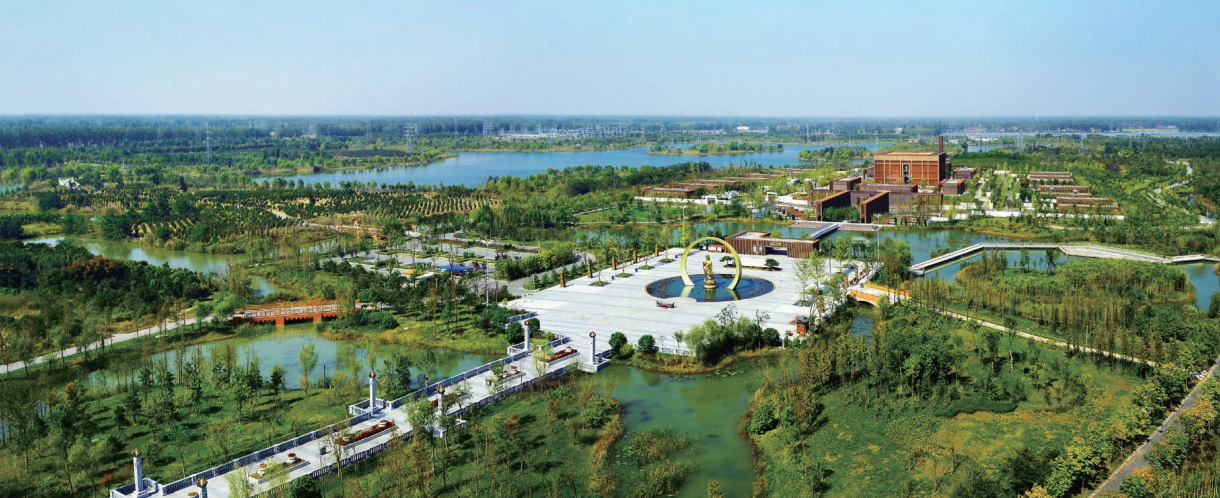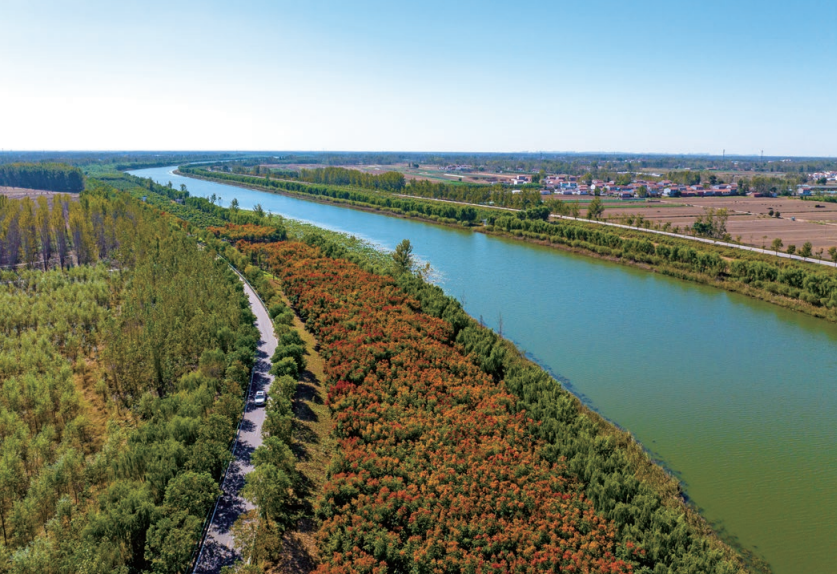Xuzhou City: Developing Forestry New Quality Productivity and Enhancing Forest Carbon Sequestration Capacity
Forests, as the main body of terrestrial ecosystems, undertake about 80% of carbon sequestration tasks and are the largest carbon pool in the system. They are an important path to achieving the "dual carbon" goal. Among them, land greening is one of the most economical, safe, and effective means of carbon sequestration and sink enhancement, and is a key measure for developing new quality productivity.
Xuzhou City, Jiangsu Province, a former old industrial base city, once had an environmental appearance of "one city of coal ash and half city of soil" due to coal mining. Under the leadership of the Municipal Party Committee and Government, the city has carried out more than 10 years of ecological restoration work, scientifically afforestation and greening, and created 1 million acres of forests. The afforestation area and forest coverage rate rank among the top in the province.

Suining Wetland Aerial Photography
Implementing ecological restoration of mountains and forests
Enhance the carbon sequestration capacity of mountains and forests
Implement the campaign to green barren mountains. In the 1980s, Xuzhou City eliminated barren mountains suitable for afforestation, but more than 100000 acres of barren mountains were still identified as "unsuitable for afforestation". Since 2007, Xuzhou City has implemented two consecutive campaigns to green barren mountains, lasting for 8 years. A total of 128000 acres of barren mountains have been greened, with over 12 million seedlings planted. More than 400 barren mountains have been covered with greenery, achieving full coverage of all barren mountains in the city and setting a successful precedent for "planting forest cities in stone crevices".
Implement forest replanting and transformation. In 2020, Xuzhou City launched a three-year action plan for ecological restoration, involving two projects: the transformation of forest landscape and the treatment of forest baldness. Implement ecological restoration of 500000 acres of pure cypress forests in the city, increase forest and seasonal changes, transform 30000 acres of forest and mountain forest, mainly carry out mixed transformation of pure cypress forests in scenic areas, and enhance the landscape effect of forests and mountains; We have implemented 5500 acres of afforestation for alopecia areata in the mountains and forests, mainly planting "three transformations", local, and precious tree species. We have selected a mixture of evergreen and deciduous tree species such as Ligustrum lucidum, Platycodon grandiflorus, Eucommia ulmoides, Acer truncatum, Acer truncatum, Acer truncatum, Acer truncatum, Eucommia ulmoides, Eucommia ulmoides, Pomegranate, Apricot, Peach, and Pear trees. By implementing ecological restoration, the landscape of mountains and forests has changed from "greening" to "beauty", comprehensively improving tree species structure and restoring biodiversity, and building an "ecological scenic forest" with high ecological functions and landscape aesthetic features.
Implement forest network construction
Building a new pattern of forest carbon sink
Since 2019, Xuzhou City has vigorously promoted seven national land greening demonstration projects, including water system, roads, farmland forest network, green and beautiful villages, barren mountain greening restoration, and forest nurturing, as well as three forest quality improvement projects, including degraded forest restoration, inefficient forest transformation, and forest landscape enhancement. It has constructed a spatial ecological network pattern of "one corridor, two belts, three networks, and multiple points". Strengthen the construction of green belts and protective forest belts along roads with the Beijing Shanghai high-speed railway, Xulian expressway, national and provincial trunk roads as the main line; Strengthen the construction of forests for water source conservation and soil and water conservation along the river and lake, build the "two ring" ecological circle along Weishan Lake and Luoma Lake, the "three river" ecological belt along the canal, the ancient Yellow River, and the Dasha River, and the "seven mountains and seven lakes" ecological points, and create the ecological corridor of the Beijing Shanghai high-speed railway, the landscape cultural belt of the Grand Canal, the green ecological corridor of the old Yellow River, the high standard farmland forest network, and the 211 demonstration highlight project of green and beautiful villages. A total of 520000 acres of trees were planted in the city, and over 1.5 million acres of farmland forest networks were updated and improved. More than 20 million trees were planted on four sides, and 300 provincial-level green and beautiful villages were built. The forest area grew rapidly, achieving a transformation from "gray" to "green".
Implement scientific afforestation
Enhance the level of new quality productivity in forestry
In 2020, the government introduced policies to curb the "non agriculturalization" of arable land and prevent the "non grainization" of arable land, which severely restricted afforestation space. Land greening is developing in depth, shifting from large-scale afforestation in the past to refined, precise, scientific, and high-quality development. Xuzhou City has planned ahead and formulated the "Implementation Plan for Scientific Greening of Land and Space" and the "14th Five Year Plan", as well as the "Implementation Opinions on Scientific Greening in Xuzhou City", to achieve the integration of multiple regulations and scientific layout of afforestation and greening spaces, and to guide scientific greening through planning.
Xinyi City is a model of afforestation and greening in Xuzhou City. It actively responds to the "double non" policy and solves the new problems of national land greening with the posture of hanging maps, such as where to plant trees, what varieties to plant, and how to manage and protect them, opening up a new path of scientific greening.
Searching for space. Through the overlay analysis of farmland, land, and forest land in Xinyi City, key areas such as roads, ditches, rivers, and lakes were identified, and non basic farmland and non forest land were accurately extracted. Combined with field investigations, the afforestation plots were listed in the "map storage" as the focus of greening. Once the space is established, efforts should be made to organize, demolish illegal constructions, widen road shoulders, dredge and dredge, replant farmland and forest nets, renovate old cemeteries, and plant forests in inefficient farmland and polluted areas, fully utilizing every inch of space.
Choose tree species. Xinyi City scientifically arranges "precious, colorful, and beneficial" tree species and local varieties based on its terrain and soil, with plains and hills, and rivers crisscrossing. Unpopulated poplar and Chinese locust are lush, while pond cypress and Luan tree stand upright. Economic trees such as peach, pear, and apple are covered in fruit branches, and precious colorful tree species such as elm and ginkgo are dotted among them, creating a lush and colorful environment.
On management and protection. Xinyi City has established a diversified investment system led by the government, coordinated by departments, and jointly governed by society. Afforestation and greening have become a concerted project, supported by continuous fiscal appropriations. Innovative mechanisms, including departmental afforestation, village enterprise co construction, and large-scale contracting, are being implemented simultaneously. Following the principle of "whoever invests benefits", models such as contract leasing and forest seedling integration are being used to activate social capital and jointly create a green new chapter.

The Peixian section of the old Yellow River channel
Through continuous exploration and innovation, Xuzhou has created a national model for the transformation of the resources of old industrial cities, realized the magnificent transformation to "one city with green mountains and half a city with lakes", won the titles of "National Forest City", "National Ecological Garden City" and "National Civilized City", won the UN Habitat Award, and has been rated as "China's happiest city" four times.
The forest area, forest stock volume, and forest carbon storage in Xuzhou City are all on the rise, effectively playing the role of forests as carbon sinks. As of 2023, the forest biomass carbon storage in the city is 20.0586 million tons, and the annual average forest biomass carbon sink is 1.8943 million tons. To maintain ecological balance, protect biodiversity, enhance forest carbon sequestration capacity, improve people's well-being, and contribute to the peak of carbon emissions in Xuzhou. (Author: Li Yali, Zang Jing)
Article source: Reprinted from "National Land Greening" magazine